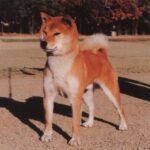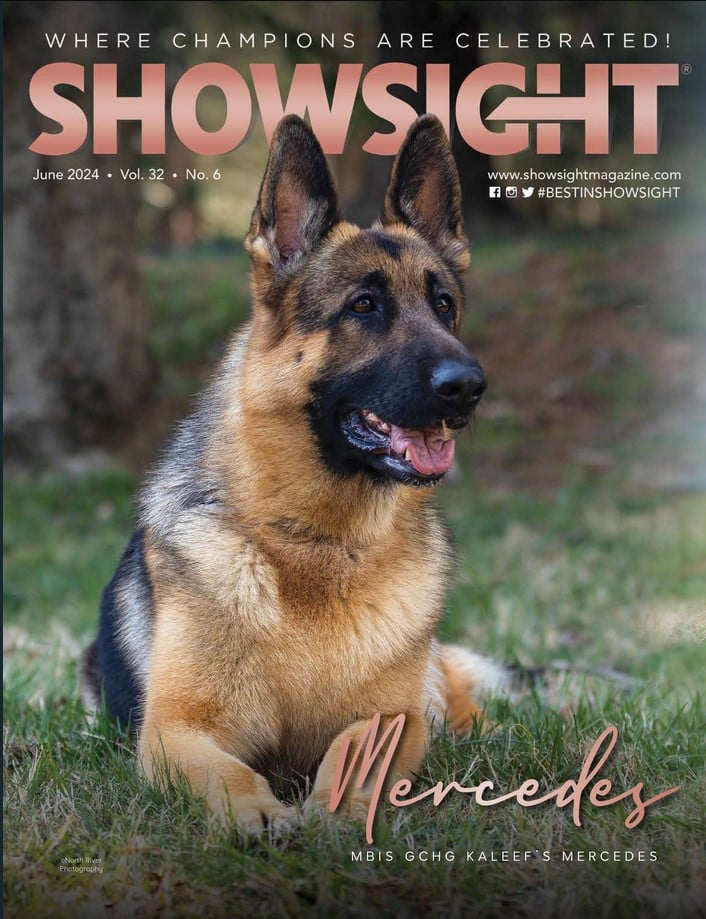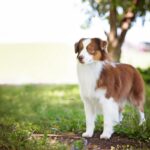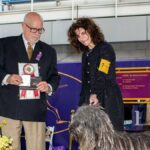This article was originally published in Showsight Magazine, January 2014 issue.
Judging the Shiba Inu
The Shiba Inu is one of the more primitive breeds in the AKC family of dogs. Japanese skeletal remains date the early ancestors of the Shiba Inu at over 10,000 years old. The domestic dog is a descendant of the Asian Gray Wolf. A study of the DNA of 85 purebred dog breeds published in the March 2012 issue of the National Geographic cites the Shiba Inu as the breed most closely aligned genetically with the Asian Gray Wolf. The Shiba has remained relatively unchanged and the primitive nature of the breed is an important element of understanding the breed. The Shiba Inu along with five other native Japanese breeds evolved over time from the original descendants of the Asian Gray Wolf. Most of the type characteristics are common among these six breeds with size and color as the primary traits that distinguish the individual breeds. The Shiba is the smallest of the native Japanese breeds. The traits that define the Shiba are a combination of form, function, and temperament.
Form Characteristics
The three areas of form that receive the most attention from breeders are the head, size, and coat color. These traits are often the most difficult to achieve and retain. The head combines the muzzle, the skull shape, the eye, the ear, and cheeks.
- The muzzle is firm with a round appearance viewed from the front. The full underjaw is the trait that contributes to the round appearance of the muzzle. The lip line is firm and straight and the pigment of the lips is black.
- The shape of the skull is defined by a moderate stop, a defined upward sloping back skull, and a broad flat forehead that may contain a slight furrow. The muzzle is roughly 40% of the skull measured from the tip of the nose to the occiput.
- The eye is deeply set and rises upward toward the base of the ear. The upper lid is somewhat triangular in shape and the lower lid is slightly rounded. The eye color is deep brown and the pigment of the eye rim is black.
- The ears are well set apart and tilt forward slightly flowing forward in the line formed by the arch of the neck. The ear is firmly pricked and triangular in shape. Viewed from the front, the pitch of the ear creates a somewhat triangular shape where the outer edge of the ear is slightly curved and the inner edge of the ears is straighter.
- The cheeks are full and proportional with the other components of the head. Balance is important when viewing the head as a whole. There is room for variance in the individual elements; however, the overall impression of the head is one where all of the components are proportional, balanced, and in harmony. The acceptable height range is important enough to merit disqualification. The Shiba Inu is not a toy dog and the undersize disqualification exists to emphasize the importance of the lower range of the acceptable height. The top end of the height range separates the Shiba Inu from the other native Japanese breeds identified as larger in size. Judges that question the height of a Shiba in the ring are encouraged to use the wicket to determine if the exhibit is within acceptable limits. The three accepted colors of the Shiba Inu are: Red, Red Sesame, and Black with Tan Points. The undercoat is soft and dense and may be white, buff, cream, tan or gray in color. Urajiro is required for all colors and is white, cream, or buff. Urajiro is required: on the sides of the muzzle, on the cheeks, inside the ears, on the underjaw and upper throat, the inside of legs, on the abdomen, around the vent, and the ventral side of the tail. The urajiro is distinct from the coat color with a graduated blending of the urajiro into the colored coat. The red is vibrant and closer to a vivid orange than red. The color is not muted appearing fawn or brownish red. The correct red sesame is one of the hardest colors to obtain. The combination of black-tipped hairs on vivid red background is distributed evenly throughout the coat and does not appear in patches or patterned. This even distribution should be present on the head and may form a widow’s peak on the forehead. The black with tan points is comprised of black guard hair containing brown or red tints. The black is not a blue black. The tan points are located as oval spots over the eyes; on the sides of the muzzle between the black bridge of the muzzle and the white cheeks; on the outside of the forelegs from the carpus, or a little above, downward to the toes; on the outside of the hind legs down the front of the stifle broadening from hock joint to toes. Tan points may also be found on the inside of the ear and underside of the tail. While other colors or color patterns may occur within the breed, these represent coloration patterns more appropriate to the other native Japanese breeds and are serious faults that must be penalized. In addition, the cream or white Shiba will not display the required contrast between coat color and the urajiro pattern required for all Shibas.
Function Characteristics
The Shiba has been utilized throughout its early history as a hunting dog. The Shiba travels a variety of terrain from high mountainous regions to open fields. The Shiba is sturdy without appearing heavy-boned or refined. The Shiba is built to work tirelessly for extended periods with balanced structure critical to performance. The Shiba possesses effortless movement allowing for bursts of speed and quick course corrections.
The Shiba thrives in extreme ranges of temperature. A trait that allows the Shiba to function in extreme weather is the coat. The Shiba carries a double coat where the guard or outer coat is coarse, stiff, and straight and the undercoat is soft and dense. A long, woolly or soft coat is faulted and it is preferred that the Shiba is presented in a natural state. Trimming or sculpting of the coat must be severely penalized.
These carnivorous dogs easily adapted to the requirements of the Japanese hunter throughout early history. Full dentition and the alignment of the teeth is an important consideration for these hunting dogs. The Shiba throughout history has been utilized as a hunter of game ranging in size from small birds to boar. The job of the Shiba when hunting boar was to contain the boar until the hunter arrived with spears. The Shiba would circle the boar attacking from the rear at the hamstrings to slow down or immobilize. The full complement of correctly aligned teeth was critical to the Shiba’s survival.
Several of the early Shibas in the foundation stock comprising the gene pool in the US had missing teeth. The version of the Standard adopted by AKC when the breed entered the Non-Sporting Group in June 1993 simply stated “full dentition preferred.” Unfortunately, several of the early AKC champions had missing teeth; some in significant numbers. The NSCA members understood the importance of honoring the judging requirements in the country of origin as well as the heritage of the breed and felt that dentition required emphasis from breeders and judges alike. The members of NSCA felt that breeders needed time to reduce the number of missing teeth and in 1997 the Standard was modified to specify that more than 4 missing teeth are a serious fault. In time the Standard may be revised in steps to specify more than two missing teeth as a serious fault, with the ultimate goal of full dentition as a requirement.
Temperament Characteristics
The Shiba Inu should carry himself with a “spirited boldness” and dignity. The Shiba Inu does not understand that he is not the biggest dog in the crowd and firmly believes that he is the most important dog in the area where he is present. The quiet confidence of the Shiba is manifested by a dog that is secure in his environment and under the control of his owner or handler. While puppies may exhibit enthusiasm for greeting any stranger, adults are often more reserved and aloof. When greeting a stranger, the adult Shiba has yet to determine if it is worth his while to expend any effort on the newcomer to his world.
Judges should not be expected to tolerate aggressive behavior from a Shiba and AKC has procedures for dogs that display aggressive behavior in the ring. Shy dogs raise a bigger question and the key element in the Standard is the word overt. A Shiba may be unsure of herself the first few times she shows and will gain confidence with each show experience. However, the Shiba that displays overt shyness with behaviors such as trembling, cringing, or low crawling should be excused. Fear-based aggression may be a factor in the show ring more often than dominance aggression. The judge or the exhibitor should not push a Shiba into a fear aggression response.
The National Shiba Club of America has developed a program for educating judges that places emphasis on judging the overall dog and discourages fault judging. The “perfect” Shiba does not exist and in most circumstances the strengths of the dog will offset any minor faults possessed by the dog. The Standard states “A harmonious balance of form, color, movement, and temperament is more critical than any one feature.








